Disclosure: Meeple Mountain received a free copy of this product in exchange for an honest, unbiased review. This review is not intended to be an endorsement.
I can picture it as clear as morning: walking with my family through a stunning Japanese garden, surrounded by the sensory delights of flowers, trees, and docile critters. Somehow, the air is hazy, casting a dreamlike hue across my field of vision. Then, the entirely expected happens as the tranquility is shattered by reality.
“I bet I can make a bigger leaf pile than you!”
“Oh yeah? Well I have more acorns!”
“I’ll let you go through this pile of leaves for an acorn!”
“Hey! You can’t move that pile once you set it down!”
Just about any activity can become a game with a few stated restrictions, a well-designed objective or two, and a playful attitude. The question in the end is whether the backyard shenanigans were just a strange moment or whether they can be whittled down into an experience that begs future visits.
Momiji, a card game collaboration from Deer Games and Japanime Games, takes this playful backyard approach into that dreamy Japanese garden and asks what happens if peaceful leaf collection suddenly grows a competitive backbone? What if acorns become the fiat currency of the garden? Can the enjoyment of nature withstand such frivolity for a span of thirty minutes? Would folks come back for more?
You may not yet know Dario Massarenti, one of the designers of Momiji, but the name Francesco Testini (Tang Garden, Xi’an) could ring a bell. The two have several collaborative designs in the works of which Momiji is the first.
One name that has caught my attention, though, is Apolline Etienne (The Quest Kids, Wreck Raiders, Living Forest), whose extraordinary artwork seems to adorn a number of projects near the top of my family board game wish list. Her efforts here are to be applauded as well, from the box to the bits inside. This successful Kickstarter from the tail end of 2020 is finally bringing its striking and oddly playful woodland economy into the retail light.
Leaves
The heart of Momiji rests in the collection of piles of beautiful leaves. The 84-card deck features six different leaves which serve as suits bearing numbers from zero to three. Players can create only one pile of each color laid out in a horizontal row before them. Piles must start with a zero on the bottom and then grow by either matching the current number or increasing by one. In other words, if a zero is showing, you may cover it with another zero or a one. When a pile receives its first three, it is considered locked and a Torii token is placed on top to prove it.
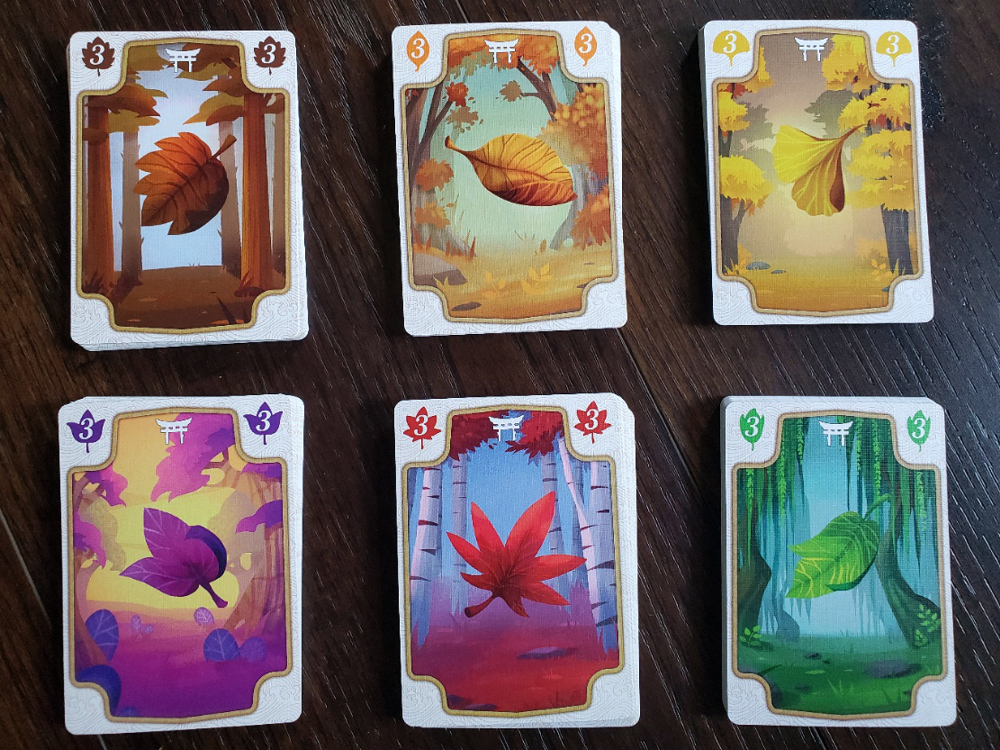
The bulk of the endgame scoring comes from multiplying the value of each pile’s top card by the number of cards in the stack. A pile containing seven cards with a three on top scores twenty-one. Simple enough, and important to grasp from the beginning.
On a player’s turn, they must take just one of three available actions. First, they can go to the display of leaf cards to collect a column of cards. During setup, four cards are revealed into the display, which is always sorted into columns of color. Collecting a column requires players to take all of the cards of a particular color. Players who choose to collect from the display can spend one acorn to reveal and sort four additional cards into the mix before choosing a color.
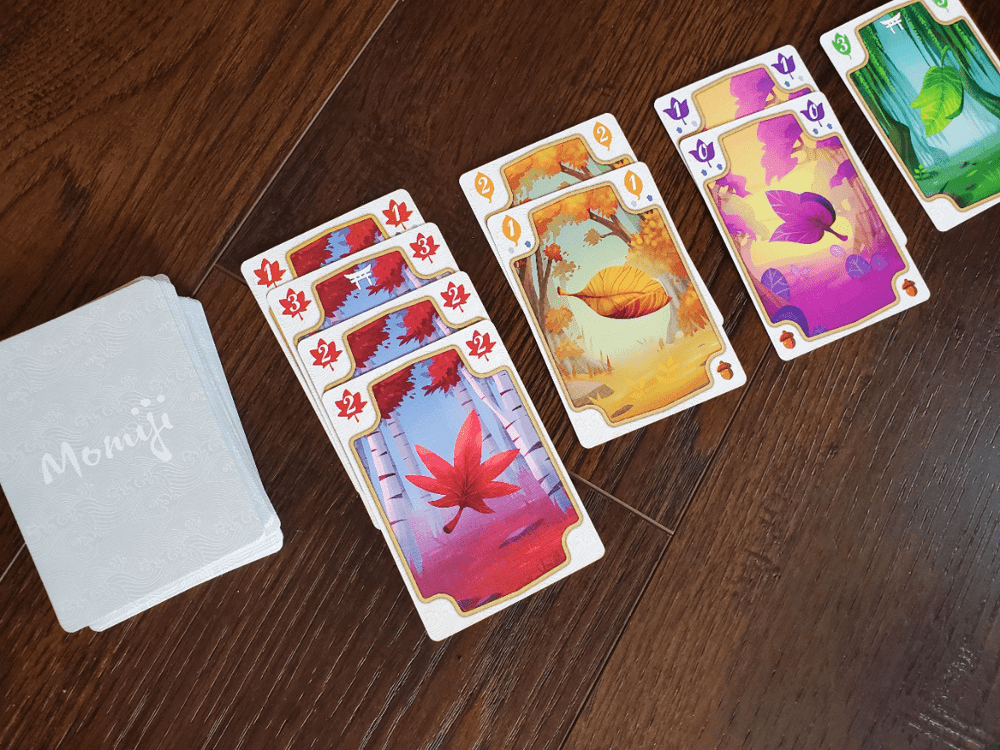
As a second choice, players can lay leaves into their display. They may choose to play two cards consecutively into one pile or a single card into as many piles as they are able. Once piles are begun, they must remain on the table in the order in which they are placed because of the mighty acorn bonus that awaits. More on that in the acorn section. Appealing to my tidy sensibilities, piles must also be kept so that only the top card is visible.
Behind door number three, players may activate one objective token. Five possible objectives are revealed during setup. In order for these objectives to score at the end, they must be activated by one of the players at a cost of three acorns. The cost is steep when only one player will score each objective. The bonus is worth more—ten points vs. three—to the player who paid to activate it, which creates an interesting draw towards being the one to pony up the acorns.
In addition to this one action, two optional actions are always available: trade two cards for an acorn, and/or activate one landscape ability, which I will describe below. Play continues either until the Torii pile is empty, meaning a certain number of threes have been played, or until the deck runs dry.
Acorns
The early strategic challenge of Momiji comes from the acorn economy. I love the acorn economy! Players start with either four or five acorns, which can be spent a number of ways. As mentioned above, they can boost collection efforts from the display during any given turn. They can be spent to activate the objectives. They can be spent to activate the landscape abilities.
But what about getting more? I already mentioned trading away cards, but that hardly seems efficient when those cards might be needed for deep piles and big points. The hand limit is eight, so there is a need for occasional discarding, but thankfully there is a more lucrative way.
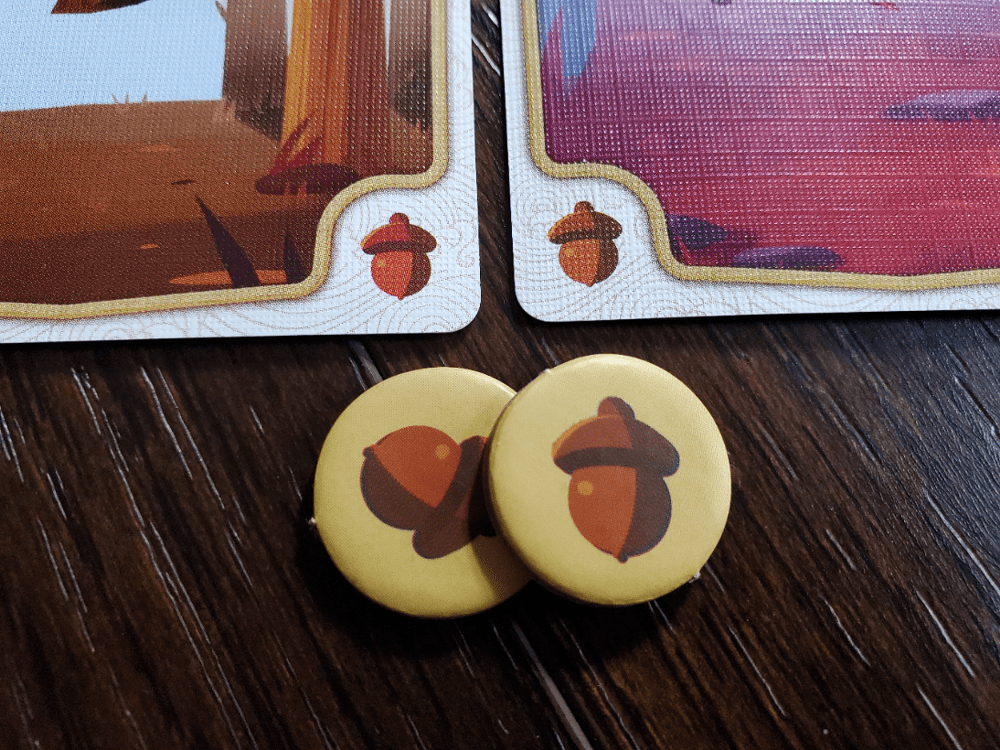
The lower cards in each leaf suit feature acorn icons on the bottom; some left, some right, some both. Any time players lay cards into multiple stacks, they are able to check to see if any acorns are paired up with the cards in the next pile. Any created pairs receive two acorns! This means it is possible to scheme for a load of acorns by drawing and laying cards in the right order. But at the same time, once you drop a two on a pile, you interrupt the supply chain, creating the need to maximize the acorns early so you can spend them late.
Acorns are worth one point each at the game’s end as well, which means the chase is hot and the decision to spend is thoughtful. There are only so many turns in the game. What to do?
Landscape
Giving the game a little extra contour, players are each blessed with three single-use landscape abilities. For the initial games, players can each use the same abilities, but there are more than thirty abilities in the game allowing for a draft during setup for more experienced players.
These cards are just lovely and enhance the theme by creating a garden panoramic above the leaf piles. Abilities range from searching the discard pile to tucking extra mismatched cards under a leaf pile. In a four-player game, there are a dozen different abilities around the table, leaving plenty of opportunity for unique maneuvers.
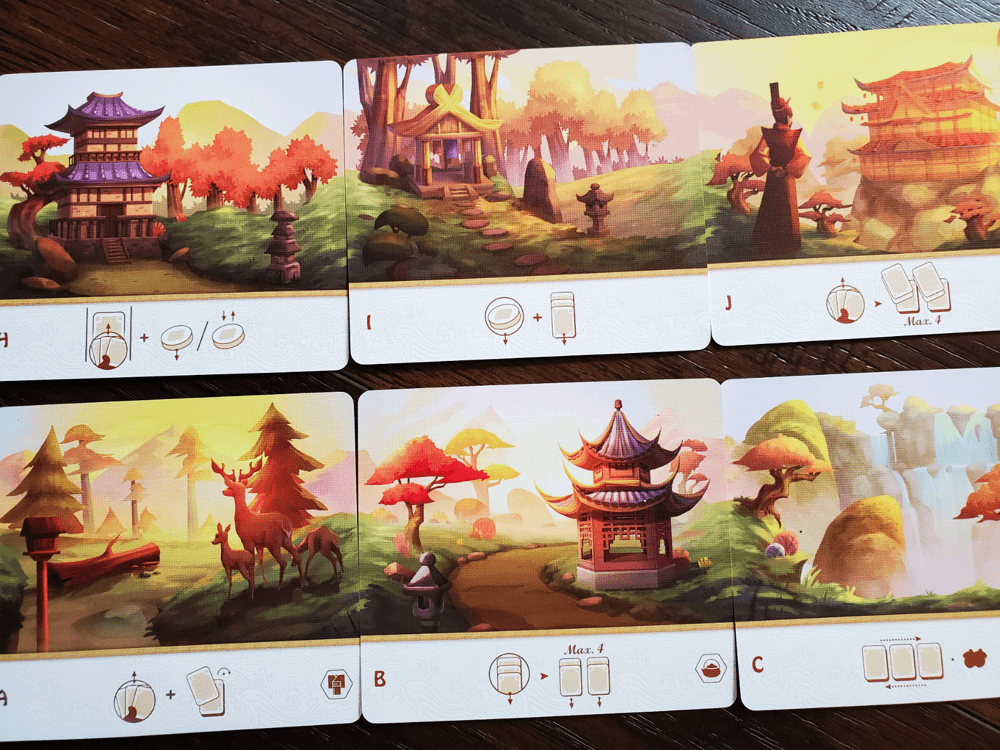
Peace
I like this one, even though I’m not sure I’ve yet had the intended experience. Maybe it’s fair to say I like this one because I’m pretty sure I’ve yet to have the intended experience.
Momiji is wonderfully strange. I can’t help but think of my kiddos and their off-the-wall backyard play when it comes to the theme and the whimsical economy. Acorns to reveal leaves. Acorns to go digging through the rejected leaves or double dip in the leaf display. Acorns to awaken special scoring objectives. Acorns as points. I suppose something had to serve as currency in this gorgeous garden! This is a cleaner and slightly more mature version of a game I could totally see my kids inventing on the picnic table with nature’s goodies.
And yet, Momiji is strangely wonderful. There is just enough elasticity packed into the cards to keep the game interesting from start to finish. When is the best time to activate objectives? Can I even win the objectives, or am I just paying the hefty cost to make sure an opponent doesn’t get the full ten points? Can I really worry about that when I need to draw those brown leaves to get my stack up to a three? Do I have enough time to worry about any of this with less than a dozen cards left in the deck?
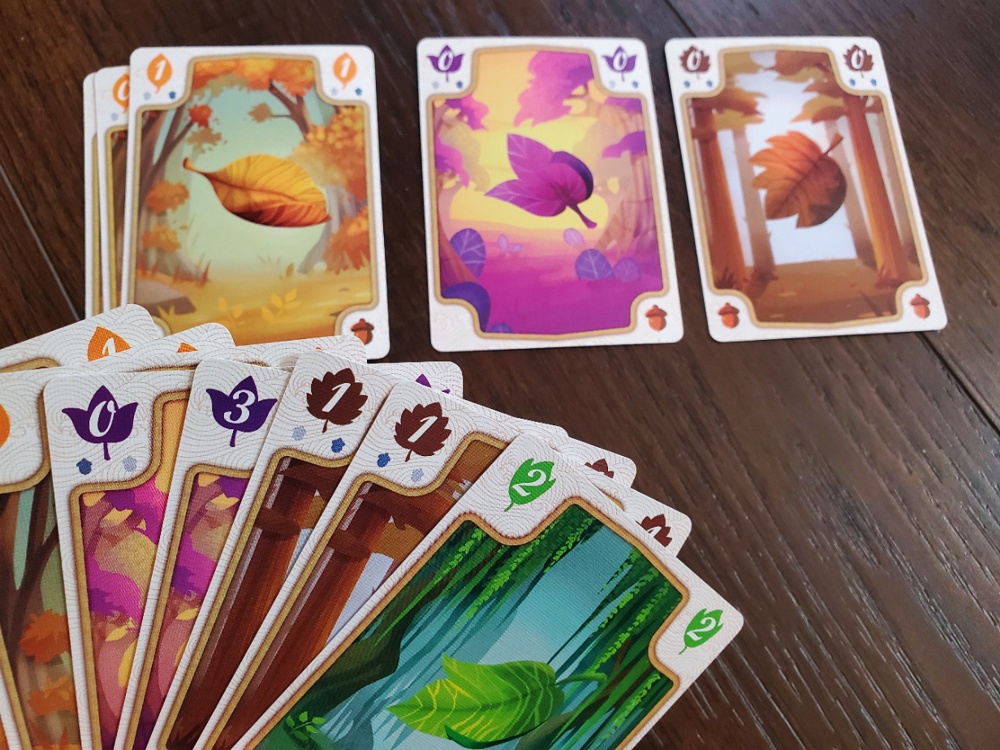
Momiji rewards attentiveness. Card counting is encouraged throughout. No joke, it’s in the rulebook. After all, knowing how many orange leaves are in this neighbor’s stack, that neighbor’s hand, and the deck might help with some of those tough decisions. Knowing how many yellow cards are right in front of you might help as well—there are rules against checking even your own stacks! But if an objective involves having the most red+yellow+orange, it behooves all to know who is in line to score it. Sure, it is possible to keep the game at a leisurely and oblivious stroll, but for the cutthroat leaf collector, counting adds an interesting layer. Personally, I’ve enjoyed simply keeping my eyes peacefully peeled—counting feels a bit too much like work.
Momiji definitely rewards familiarity. That first play is likely to be a garden variety disaster as desired objectives are scooped away along with those needed cards and any sense of willful efficiency. The losing experience is vital, however, because as the score is calculated a number of things become clear. The second game will be more efficient. The third game will be downright interesting as players start to feel the asymmetric tension that was hovering in the aether all along.
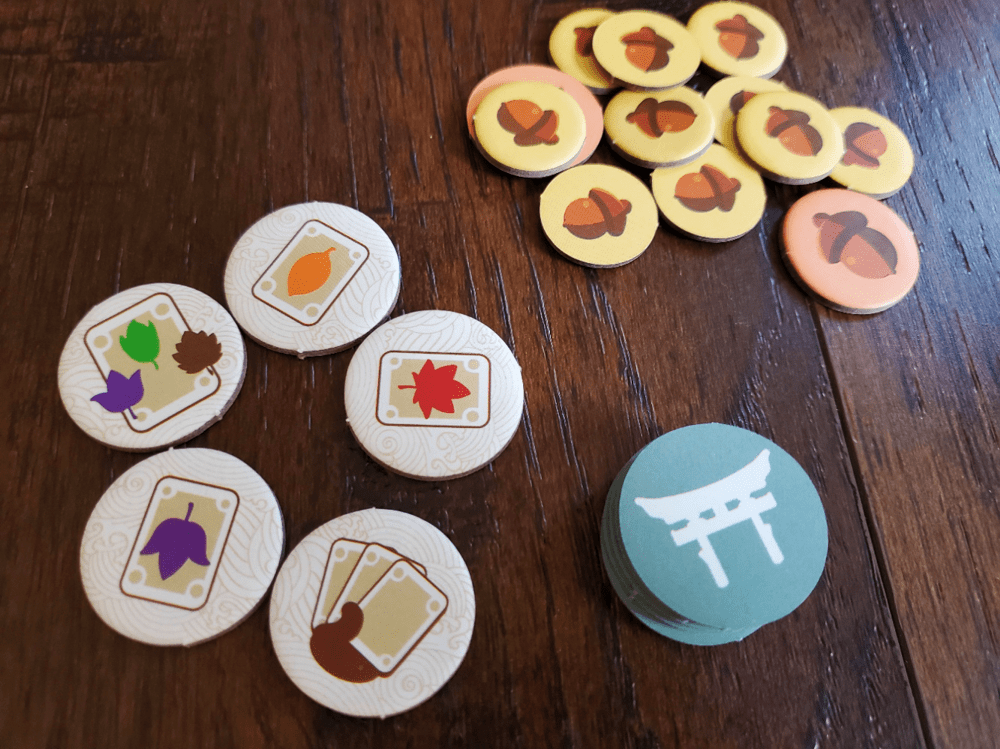
Scoring is somewhat erratic from game to game depending on the familiarity of the group. Most of my games have resulted in a wide range. Two-player games boast of breathing room and higher scores due to less player interference. I felt as if I could take an extra turn to set up a big acorn play during the head-to-head matchups. Four-player games ratchet up the stress on decisions throughout and could drive a wedge between the high and low scores based on who owns the better timing. The lay of the land can change radically between turns with a full table, increasing the tension. I wouldn’t say there is an ideal player count, only a variety of experiences, all of which require enough commitment to lose, learn, walk away, and come back.
If I must gripe, the iconography is not great, but serviceable. It fits the artistic vision, but the learning curve is steeper than expected. The objective tiles are clear enough, but with thirty landscape abilities, comfort will require repeated exposure. Even after four or five plays, I don’t find them to be intuitive. Thankfully, the rulebook is clear and there are only three cards to be learned at a time for each player. I applaud the effort at language independence, but I’ve seen better implementation. Let’s just say the superb artwork serves as a sufficient offsetting bribe for me. I’ll let it pass.
Momiji sets out to be a romantic painting, a natural poem of sorts as players gobble up the falling leaves in an exercise of appreciation. I’m up for the imaginative ride. In this little Japanese garden I get to think, but I don’t have to sweat. Despite the wide array of scores, Momiji makes me believe the curve will continue to flatten and that some delightful and tightly played experiences are yet to come. It has earned the opportunity to prove me right.





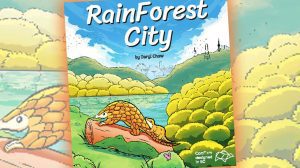






Add Comment